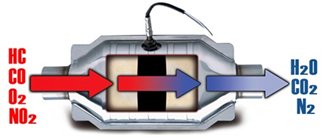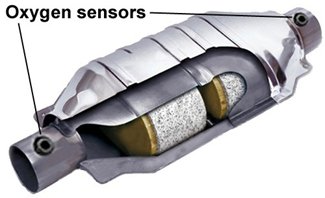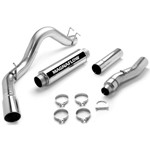
Catalytic Converters
General Information
A catalytic converter minimizes harmful emissions from the exhaust of a "properly tuned" combustion engine. This process occurs when heat combines with a precious metal catalyst that either oxidizes (burns) or reduces harmful emissions to safe elements in the exhaust flow. If the engine is out of tune and not calibrated to OEM (original equipment manufacturer) specifications, the catalytic converter's efficiency greatly diminishes, and this breakdown could lead to converter failure.
The catalytic converter consists of a ceramic honeycomb substrate (sometimes called a "brick" or "biscuit") coated with a metal catalyst, usually platinum, rhodium and/or palladium. The ceramic contains hundreds of flow channels that expose the exhaust gases to a maximum amount of surface area and where the catalyst reaction takes place, converting pollutants into harmless gases and water. The catalyst must come in direct contact with the exhaust gases for the reaction to happen. If the ceramic inside the converter becomes clogged or coated with carbon, lead or oil, the converter becomes less efficient.
In addition to being coated with a metal catalyst, the substrate is wrapped in a mat that expands when heated. This expansion secures and insulates the substrate during operation. The substrate and mat are then packaged in a stainless steel outer shell and fitted into the exhaust system. Generally, this entire unit is referred to as the "catalytic converter." The exact position of the converter in the exhaust system depends on the vehicle, but it is always located between the manifold and muffler. As explained below, there can be more than one converter per vehicle.
Types of Converters
Pre-converters
All catalytic converters must reach a minimum operating temperature before any emission reduction or oxidation occurs. The converter is least efficient during this warm-up period, which happens immediately after a vehicle's engine starts. The vehicle also expels most pollutants during this warm-up period. To offset these difficulties, some vehicles have a pre-converter in the exhaust system immediately following the manifold. The pre-converter's small size and proximity to the engine allow it to heat up and begin functioning in less time than the main converter. It also pre-heats the exhaust gases and helps the main converter to reach its operating temperature sooner.
Primary Converters
Converters have undergone several changes since they were first used in automobiles in 1975. Early models used a pelletized catalyst, but most modern converters are now designed with a free-flowing honeycomb ceramic catalyst. The type of converter required on a particular vehicle varies with model year, engine size and vehicle weight. Some vehicles use more than one type of converter to meet emissions standards.
Pre-OBD-II (1995 and older)
General Information
"On-board diagnostics" (OBD) is the term used for an automobile's capability to indicate problems through a number of codes and malfunction lights. There have been several advancements in the development of these systems. Early models of OBD, called OBD-I, did not provide enough information for repair technicians to pinpoint the exact problem. Further problems arose because industry-wide standards were not implemented until 15 to 20 years after its inception. Several manufacturers installed OBD-I systems in their vehicles, but not all the systems performed the same functions. In 1987, the California Air Resources Board (CARB) required all vehicles sold in the state to include OBD-I technology because of stricter emissions control laws. However, because there was a lack of industry-wide implementation in this period, this is generally known as the "pre-OBD-II era."
Pre-OBD-II Converters
Two-way converters were used on vehicles made between 1975 and 1980. They oxidize unburned harmful hydrocarbons (HC), carbon monoxide (CO) and secondary oxygen (O2) into water vapor (H2O) and carbon dioxide (CO2). These converters work most effectively in conjunction with engines that have a lean air-to-fuel ratio because of the dense amount of oxygen the engine provides to oxidize (burn) the pollutants. A lean air-to-fuel ratio has a high concentration of oxygen, whereas a rich air-to-fuel ratio has a high concentration of fuel.
Three-way converters are essentially two converters in one. They contain two catalysts: a reduction catalyst, located toward the front, and an oxidation catalyst at the rear. The reduction catalyst breaks down nitrogen oxides (NOx) to nitrogen gas (N2), and the oxidation catalyst burns harmful hydrocarbons and carbon monoxide into water and carbon dioxide. There have been several advancements in three-way converters. Following are the most common pre-OBD-II types.

- Three-way with air converters, developed in the 1980s, are not typically seen on today's automobiles. Because the oxidation catalyst requires a lean air-to-fuel ratio to carry out the chemical reaction, an air tube pumps oxygen into the space between the reduction and oxidation substrates to aid the process. These converters are easily recognizable by the air tube, which is inserted near the middle of the converter. In the diagram below, the black area in the center of the drawing indicates the space where the secondary air is pumped, and the surrounding beige areas represent the two catalyst substrates.
- Since the late 1980s, three-way converters began using one or more sensors to monitor the oxygen levels in the exhaust stream. These converters store and release oxygen on a single substrate to break down harmful gases. The oxygen sensors inform the engine when the air-to-fuel ratio becomes too lean or too rich. The engine responds by oscillating between lean and rich conditions. If the condition is lean, the engine releases more fuel; if it is rich, the engine releases less fuel.
OBD-II (1996 and newer)
General Information
OBD-II systems are much more highly sophisticated than pre-OBD-II systems. They survey the engine and emission control equipment to ensure that all systems are functioning properly. Federal law requires them on all passenger vehicles manufactured since 1996. The computer stores fault codes, and when the computer detects a problem, the malfunction indicator lamp (MIL) goes off. The most common MIL warning is the "Check Engine" light on the instrument panel. Any MIL light indicates to the owner that the vehicle should be taken in for service. Service technicians can then read the fault code from the OBD-II computer to determine necessary repairs.
OBD-II Converters
OBD-II converters are implemented on vehicles equipped with OBD-II systems. All passenger automobiles manufactured in 1996 and later are OBD-II vehicles. Some 1994 and 1995 models are OBD-II vehicles. Modern three-way OBD-II converters are the most sophisticated type available. Here, the engine plays a vital role by using an improved combustion chamber design and advanced electronic fuel injection technology. Similar to three-way converters with oxygen sensors, OBD-II converters have a variety of sensors and controls to help maintain a proper fuel-to-air ratio. These tools ensure that OBD-II converters are the most environmentally efficient of any converters.
Checking the exhaust system will give you a good indication whether your vehicle is equipped with OBD-II technology. If there are any oxygen sensors in the exhaust stream, your vehicle has OBD-II technology. Some manufacturers place an emissions label somewhere in the engine compartment. This emissions label contains various information, including any OBD-II compliance. The diagram below shows two substrates inside the converter, and there are two oxygen sensors on either neck.

Oxygen sensors in an OBD-II exhaust system can help to estimate emissions levels, but they cannot measure the levels directly. Because of this limitation, it is possible for a catalytic converter to meet emissions standards and yet display a "Check Engine" light on the instrument panel. As a result, aftermarket converters must be compatible with a vehicle's OBD-II system, in addition to meeting emissions requirements.
Because CARB has enacted a stricter set of emissions laws in the state of California, you cannot select a converter based on a vehicle engine size and test weight, which is typically the selection method for the other 49 states and Canada. Each converter must be tested for each vehicle by CARB, and only those approved can be used in California. Converters not approved by CARB cannot be used in California, but converters that are CARB-approved can be used outside California. Those approved by CARB are called "50-state converters," and the non-CARB-approved converters are called "49-state converters." In contrast to 49-state converters, 50-state converters contain a more active catalyst that surrounds larger, more heavily loaded substrates. They also withstand higher temperatures to meet rigid emissions standards. Consequently, 50-state converters have a significantly improved environmental impact over 49-state converters. To help you find the correct converter for your vehicle, see our FitGuide.
Departments
Towing
- Trailer Hitch
- Fifth Wheel
- Gooseneck
- Towing a Vehicle
- Front Hitch
- RV Hitch
- ATV Hitch
- HD Truck Hitch
- Vehicle Wiring
- Brake Controller
- Ball Mounts
- Weight Distribution
Sports and Recreation
Trailer Parts
- Utility Trailer
- Boat Trailer
- Landscape Trailer
- Enclosed Trailer
- 5th/Camper Trailer
- Car Hauler
- Horse Trailer
Vehicle
Contact & Help

What our customers are saying:
"Easy place to shop. Fast delivery and great products. Very happy with my purchase."
Popular Vehicles
- Subaru Forester
- Ford F-350 Super Duty
- Ford F-250 Super Duty
- Chevrolet Silverado 1500
- Jeep Wrangler Unlimited
- Jeep Wrangler
- Ram 3500
- Toyota Highlander
- Ram 2500
- Chevrolet Silverado 2500
- Subaru Outback Wagon
- Chevrolet Silverado
- Dodge Ram Pickup
- GMC Sierra 2500
- Ram 1500
- Ford F-250 and F-350 Super Duty
- Jeep Grand Cherokee
- Toyota Tacoma
- GMC Sierra 3500
- Toyota Tundra
- Ford Escape
- More >>


